David Dehaene
Re-parameterizing VAEs for stability
Jun 25, 2021



Abstract:We propose a theoretical approach towards the training numerical stability of Variational AutoEncoders (VAE). Our work is motivated by recent studies empowering VAEs to reach state of the art generative results on complex image datasets. These very deep VAE architectures, as well as VAEs using more complex output distributions, highlight a tendency to haphazardly produce high training gradients as well as NaN losses. The empirical fixes proposed to train them despite their limitations are neither fully theoretically grounded nor generally sufficient in practice. Building on this, we localize the source of the problem at the interface between the model's neural networks and their output probabilistic distributions. We explain a common source of instability stemming from an incautious formulation of the encoded Normal distribution's variance, and apply the same approach on other, less obvious sources. We show that by implementing small changes to the way we parameterize the Normal distributions on which they rely, VAEs can securely be trained.
Graph Context Encoder: Graph Feature Inpainting for Graph Generation and Self-supervised Pretraining
Jun 18, 2021

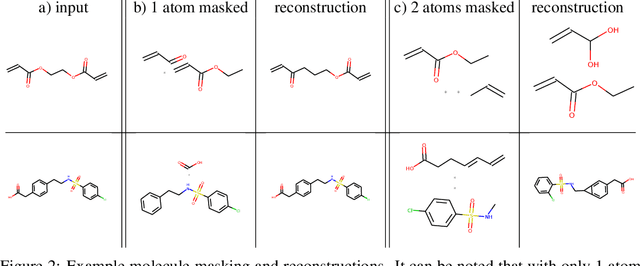

Abstract:We propose the Graph Context Encoder (GCE), a simple but efficient approach for graph representation learning based on graph feature masking and reconstruction. GCE models are trained to efficiently reconstruct input graphs similarly to a graph autoencoder where node and edge labels are masked. In particular, our model is also allowed to change graph structures by masking and reconstructing graphs augmented by random pseudo-edges. We show that GCE can be used for novel graph generation, with applications for molecule generation. Used as a pretraining method, we also show that GCE improves baseline performances in supervised classification tasks tested on multiple standard benchmark graph datasets.
Realistic molecule optimization on a learned graph manifold
Jun 03, 2021

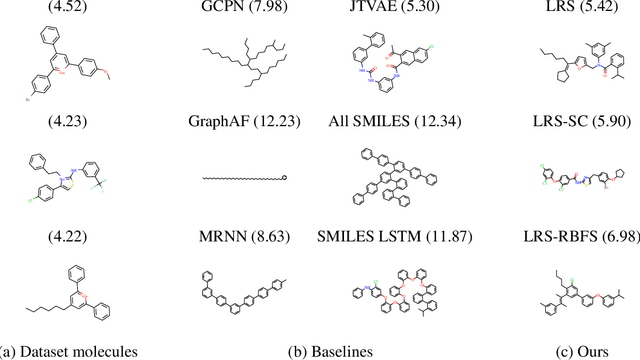
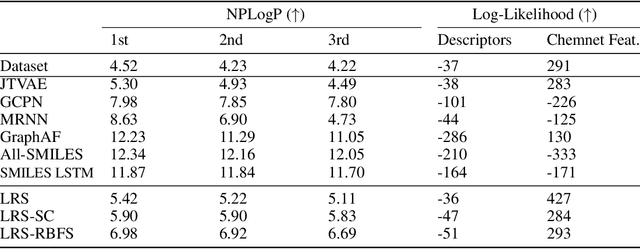
Abstract:Deep learning based molecular graph generation and optimization has recently been attracting attention due to its great potential for de novo drug design. On the one hand, recent models are able to efficiently learn a given graph distribution, and many approaches have proven very effective to produce a molecule that maximizes a given score. On the other hand, it was shown by previous studies that generated optimized molecules are often unrealistic, even with the inclusion of mechanics to enforce similarity to a dataset of real drug molecules. In this work we use a hybrid approach, where the dataset distribution is learned using an autoregressive model while the score optimization is done using the Metropolis algorithm, biased toward the learned distribution. We show that the resulting method, that we call learned realism sampling (LRS), produces empirically more realistic molecules and outperforms all recent baselines in the task of molecule optimization with similarity constraints.
Graph convolutions that can finally model local structure
Nov 30, 2020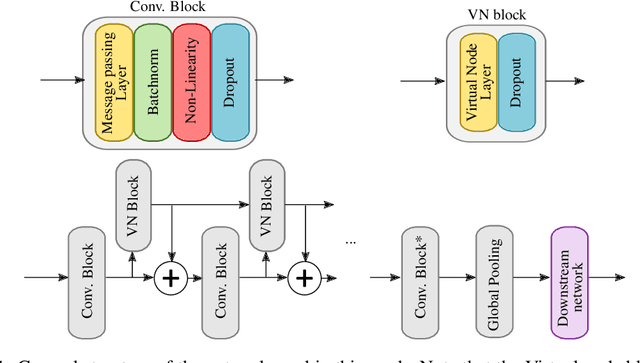

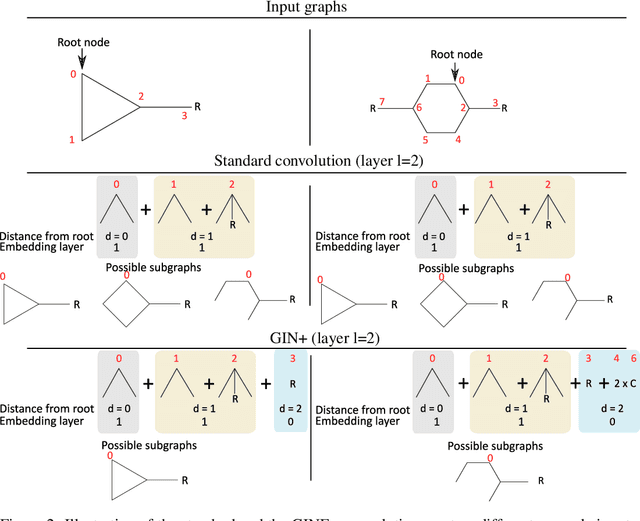
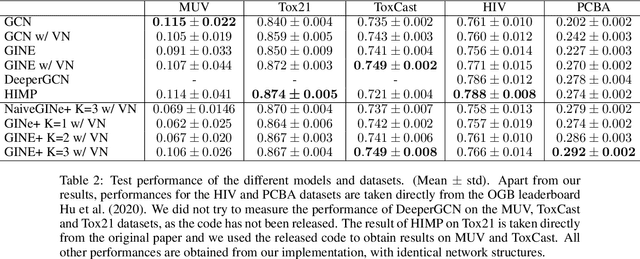
Abstract:Despite quick progress in the last few years, recent studies have shown that modern graph neural networks can still fail at very simple tasks, like detecting small cycles. This hints at the fact that current networks fail to catch information about the local structure, which is problematic if the downstream task heavily relies on graph substructure analysis, as in the context of chemistry. We propose a very simple correction to the now standard GIN convolution that enables the network to detect small cycles with nearly no cost in terms of computation time and number of parameters. Tested on real life molecule property datasets, our model consistently improves performance on large multi-tasked datasets over all baselines, both globally and on a per-task setting.
Anomaly localization by modeling perceptual features
Aug 12, 2020



Abstract:Although unsupervised generative modeling of an image dataset using a Variational AutoEncoder (VAE) has been used to detect anomalous images, or anomalous regions in images, recent works have shown that this method often identifies images or regions that do not concur with human perception, even questioning the usability of generative models for robust anomaly detection. Here, we argue that those issues can emerge from having a simplistic model of the anomaly distribution and we propose a new VAE-based model expressing a more complex anomaly model that is also closer to human perception. This Feature-Augmented VAE is trained by not only reconstructing the input image in pixel space, but also in several different feature spaces, which are computed by a convolutional neural network trained beforehand on a large image dataset. It achieves clear improvement over state-of-the-art methods on the MVTec anomaly detection and localization datasets.
Iterative energy-based projection on a normal data manifold for anomaly localization
Feb 10, 2020
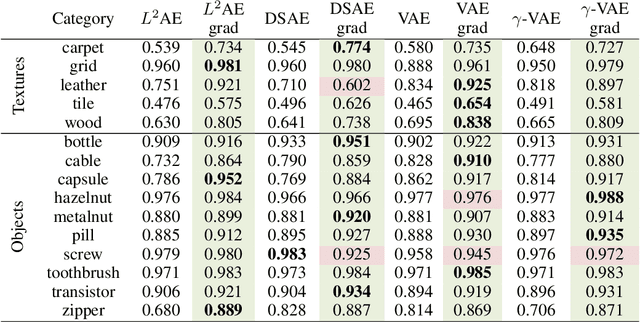

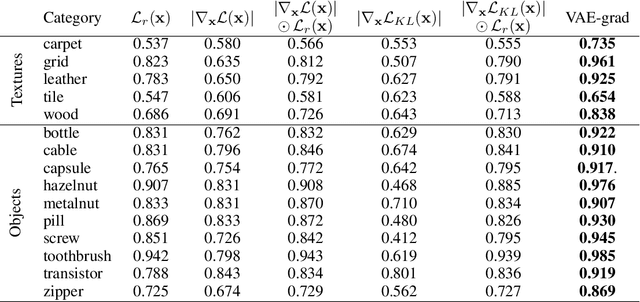
Abstract:Autoencoder reconstructions are widely used for the task of unsupervised anomaly localization. Indeed, an autoencoder trained on normal data is expected to only be able to reconstruct normal features of the data, allowing the segmentation of anomalous pixels in an image via a simple comparison between the image and its autoencoder reconstruction. In practice however, local defects added to a normal image can deteriorate the whole reconstruction, making this segmentation challenging. To tackle the issue, we propose in this paper a new approach for projecting anomalous data on a autoencoder-learned normal data manifold, by using gradient descent on an energy derived from the autoencoder's loss function. This energy can be augmented with regularization terms that model priors on what constitutes the user-defined optimal projection. By iteratively updating the input of the autoencoder, we bypass the loss of high-frequency information caused by the autoencoder bottleneck. This allows to produce images of higher quality than classic reconstructions. Our method achieves state-of-the-art results on various anomaly localization datasets. It also shows promising results at an inpainting task on the CelebA dataset.
 Add to Chrome
Add to Chrome Add to Firefox
Add to Firefox Add to Edge
Add to Edge